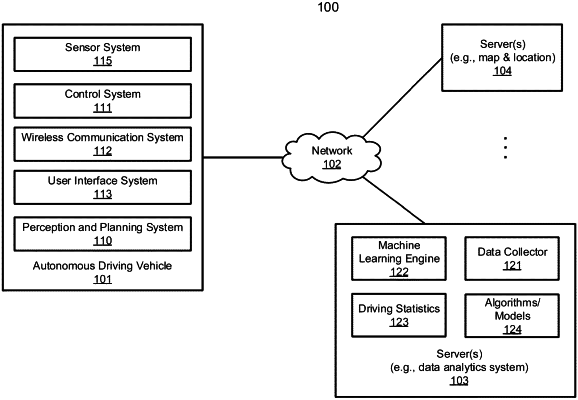| CPC G05D 1/0212 (2013.01) [B60W 30/0956 (2013.01); G05D 1/0088 (2013.01); G05D 1/0214 (2013.01); G06N 3/04 (2013.01); G06V 10/44 (2022.01); G06V 10/764 (2022.01); G06V 10/82 (2022.01); G06V 20/58 (2022.01); G06V 20/588 (2022.01); G05D 2201/0213 (2013.01)] | 26 Claims |

|
1. A computer-implemented method for operating an autonomous driving vehicle (ADV), the method comprising:
determining, by a processor, an obstacle state evolution of a spatial position of a moving obstacle over a period of time determined by using a first multi-layer perceptron (MLP) network;
determining, by the processor, a lane-obstacle relation evolution of the moving obstacle with each of one or more lanes near the moving obstacle over the period of time determined by using a second MLP network based on the moving obstacle's changing relation with each of the one or more lanes by using an aggregated lane encoding and an intended movement of the moving obstacle, including:
determining the intended movement of the moving obstacle by using non-Euclidean methods based on that the moving obstacle tends to follow the one or more lanes based on a current position of each of the one or more lanes to the moving obstacle and a future shape of each of the one or more lanes based on an overall lane encoding formed from a concatenation by a lane encoding for each lane, a current relative position for each lane, and a subsequent shape for each lane, wherein the first MLP network and the second MLP network are different and include an input layer, a hidden layer and an output layer;
determining an attention score for each lane based on the current relative position for each lane and the lane encoding for each lane; and
determining the aggregated lane encoding based on each lane's overall lane encoding and each lane's attention score;
planning, by the processor, a trajectory of the ADV to control the ADV to avoid a collision with the moving obstacle based on the determined intended movement of the moving obstacle, the obstacle state evolution and the lane-obstacle evolution; and
controlling, by the processor, the ADV to navigate based on the planned trajectory of the ADV.
|